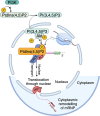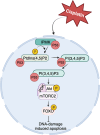The oily nucleus- role of phospholipids in genome biology: membrane-directed roles and signaling in the nucleoplasm
- PMID: 40711532
- PMCID: PMC12297164
- DOI: 10.1007/s00018-025-05825-3
The oily nucleus- role of phospholipids in genome biology: membrane-directed roles and signaling in the nucleoplasm
Abstract
Phospholipids, widely known for their structural role in cellular membranes, are now also recognized to play pivotal roles in signal transduction, metabolism, and cellular homeostasis. However, the nucleus is often overlooked in the context of phospholipid biology. The dynamic abundance and precise management of the turnover of nuclear phospholipids by dedicated kinases, phosphatases, and phospholipases implies specialized functions. Like the cytoplasm, many of these biological roles occur or are initiated within the nuclear membrane. However, several aspects of nuclear phospholipid biology appear to be based in the nucleoplasm and are mediated by dynamic and soluble lipoprotein complexes. In many cases, the exact working spaces and molecular mechanisms of action of nuclear phospholipids are not yet clearly defined, and their physiology is likely underestimated due to technical challenges. Nonetheless, in recent years, the impact of nuclear phospholipids on the structure and function of the genome has been found to be more multifaceted and complex. In this review, we summarize recent insights into the interactions and biological roles of phospholipids with respect to chromatin, gene regulation, and nuclear physiology, and discuss these roles in the context of two broad functional domains - the nuclear membrane and the nucleoplasm. We argue that a more detailed understanding of the molecular working modes of nuclear phospholipids is crucial to enable their full scientific comprehension, especially when the exploration of the biology of nuclear phospholipids and their dysregulation may offer promising avenues for diagnosis and therapeutic interventions for various genome-linked diseases.
Keywords: Chromatin remodeling; Gene expression; Nuclear membrane; Nuclear signaling; Nucleus; Phosphoinositides; Phospholipids.
© 2025. The Author(s).
Conflict of interest statement
Declarations. None. Ethics approval and consent to participate: Not applicable. Consent for publication: All authors have approved the manuscript and agree with submission to Cellular and Molecular Life Sciences. Competing interests: The authors declare that work on this article was conducted in the absence of any commercial or financial relationships that could be construed as a potential conflict of interest.
Figures







Similar articles
-
Short-Term Memory Impairment.2024 Jun 8. In: StatPearls [Internet]. Treasure Island (FL): StatPearls Publishing; 2025 Jan–. 2024 Jun 8. In: StatPearls [Internet]. Treasure Island (FL): StatPearls Publishing; 2025 Jan–. PMID: 31424720 Free Books & Documents.
-
Sexual Harassment and Prevention Training.2024 Mar 29. In: StatPearls [Internet]. Treasure Island (FL): StatPearls Publishing; 2025 Jan–. 2024 Mar 29. In: StatPearls [Internet]. Treasure Island (FL): StatPearls Publishing; 2025 Jan–. PMID: 36508513 Free Books & Documents.
-
Management of urinary stones by experts in stone disease (ESD 2025).Arch Ital Urol Androl. 2025 Jun 30;97(2):14085. doi: 10.4081/aiua.2025.14085. Epub 2025 Jun 30. Arch Ital Urol Androl. 2025. PMID: 40583613 Review.
-
Systemic Inflammatory Response Syndrome.2025 Jun 20. In: StatPearls [Internet]. Treasure Island (FL): StatPearls Publishing; 2025 Jan–. 2025 Jun 20. In: StatPearls [Internet]. Treasure Island (FL): StatPearls Publishing; 2025 Jan–. PMID: 31613449 Free Books & Documents.
-
Relationship between Pituitary Gland and Stem Cell in the Aspect of Hormone Production and Disease Prevention: A Narrative Review.Endocr Metab Immune Disord Drug Targets. 2025;25(7):509-526. doi: 10.2174/0118715303314551241031093717. Endocr Metab Immune Disord Drug Targets. 2025. PMID: 39812047 Review.
References
-
- Alberts B, Lewis JA (2002) J, et al., The lipid Bilayer, in Molecular biology of the cell, 4th, Editor. edn. Garland Science, New York
-
- Torres TE-BaA (2016) Phospholipids: Physiology. Ecyclopedia of food and health, vol 3. Elsevier Ltd, Brazil, pp 352–359
-
- Dowhan W (2007) The role of phospholipid in cell function. In: R. W. Gross (ed) Advances in Lipobiology, Vol. 2, 1997. Elsevier. pp 79–107
-
- Manzoli FA et al (1977) Chromatin phospholipids in normal and chronic lymphocytic leukemia lymphocytes. Cancer Res 37(3):843–849 - PubMed
-
- Rose HG, Frenster JH (1965) Composition and metabolism of lipids within repressed and active chromatin of interphase lymphocytes. Biochim Biophys Acta 106(3):577–591 - PubMed
Publication types
MeSH terms
Substances
LinkOut - more resources
Full Text Sources

